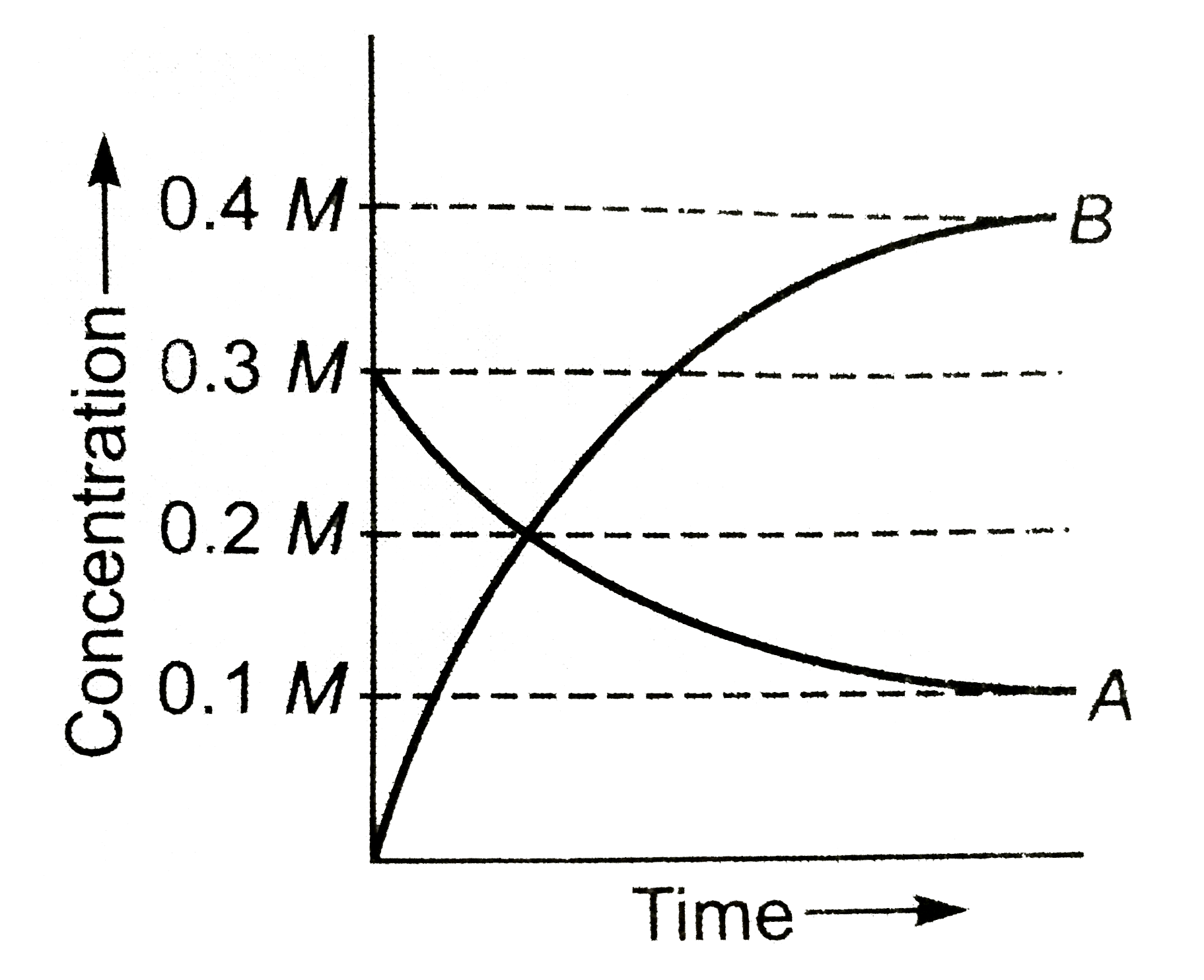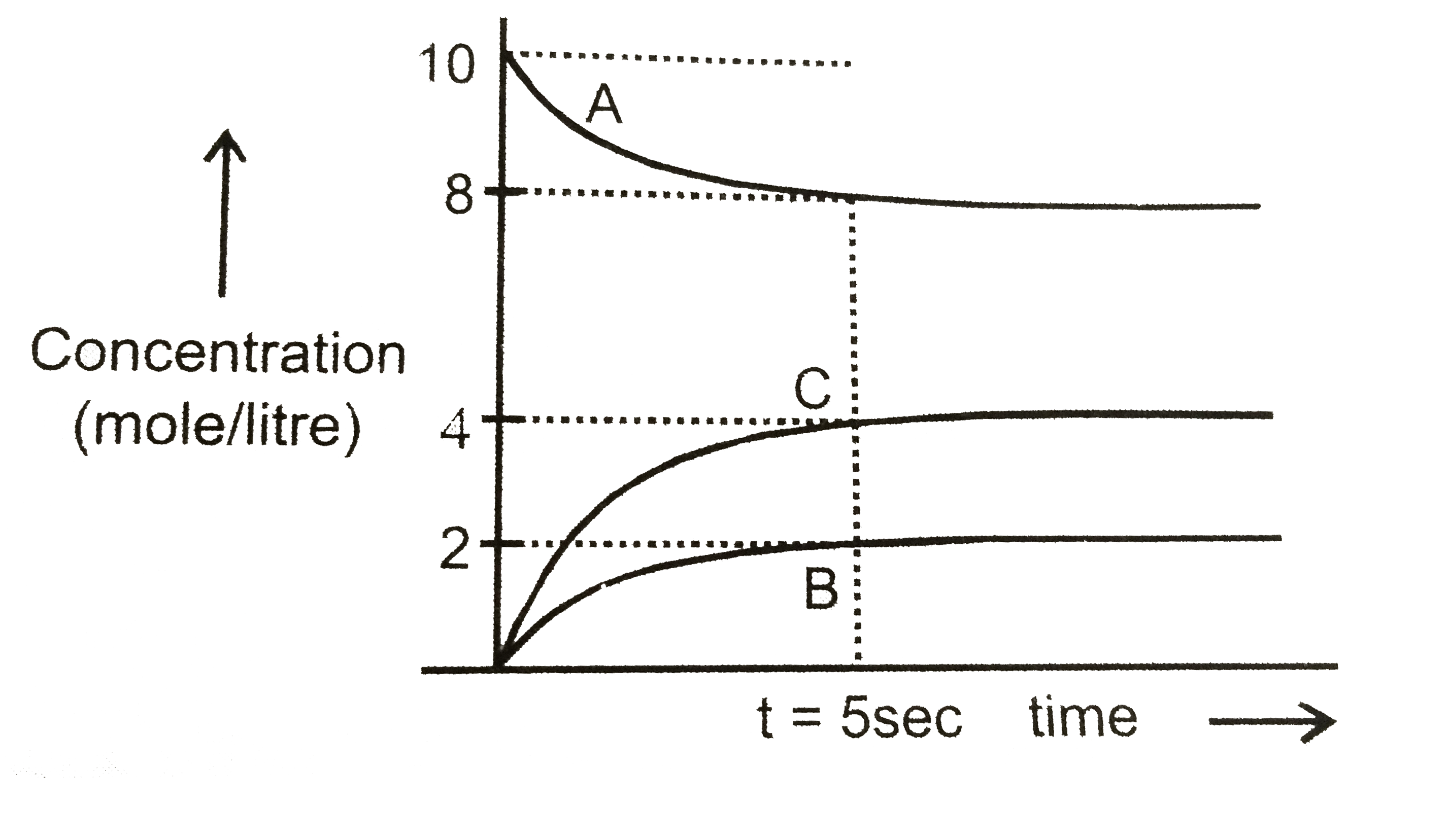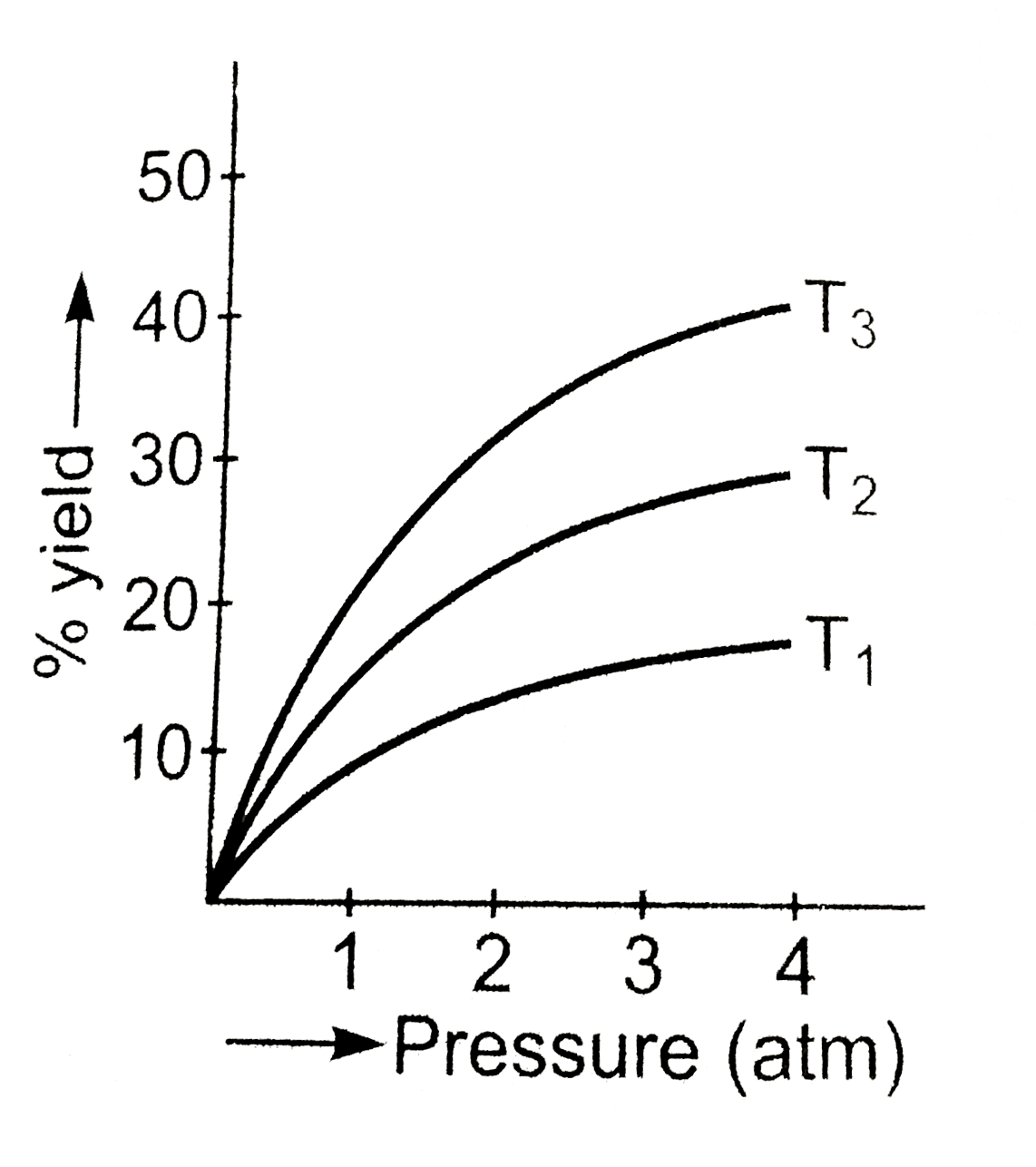Complete Solutions to Exercise of chapter CHEMICAL EQUILIBRIUM of Class 11 book with complete answers and questions
| Class 11 | CHEMISTRY |
| Chapter | CHEMICAL EQUILIBRIUM |
| NARENDRA AWASTHI | Exercise |
| Number Of Questions | 100 |
| Academic Year | 2023-24 |
A reversible reaction is one which
View SolutionThe equilibrium constant `K_(c)` for the reaction
`P_(4)(g)hArr 2P_(2)(g)`
is 1.4 at `400^(@)C.`Suppose that 3 moles of `P_(4)(g)` and 2 moles of `P_(2)(g)`are mixed in 2 litre container at`400^(@)C.` What is the value of reaction quotient`(Q_(c))`?
View SolutionIn a chemical reaction, equilibrium is said to have been established when the
View SolutionThe equilibrium constant for a reaction is K, and the reaction quotient is Q . For a particular reaction mixture , the ration `(K)/(Q)` is 0.33. this means that:
View SolutionConsider the reaction `2SO_(2)(g)+O_(2)(g)hArr2SO_(3)(g)` for which `K_(c)=278M^(-1)`.0.001 mole ofeach of the reagents `SO_(2)(g),O_(2)(g)and SO_(3)(g)` are mixed in a 1.0 L flask . Dterminr=e the reaction quotient of the system and the spontaneus direction of the system:
View SolutionIn Q.No .5, if the mixture of gases was allowed to come to quilibrium .The volume of the reaction vessel was then rapidly increased by a factor of two .As a result of the change the reaction quotient `(Q_(c))` would:
View SolutionFor the reaction `A(g) +3B(g) hArr 2C(g) `at `27^(@)C`, 2 moles of `A`, 4 moles of B and 6 moles of C are present in 2 litre vessel. If `K_(c)` for the reaction is 1.2, the reaction will proceed in `:`
View SolutionFor a reversible gaseous reaction `N_(2)+3H_(2)hArr2NH_(3)` at equilibrium , if some moles of `H_(2)` are replaced by same number of moles of `T_(2)` (T is tritium , isotope of H and assume isotopes do not have different chemical properties ) without affecting other parameters , then:
View SolutionFor the synthesis of ammonia by the reaction `N_(2)+3H_(2)hArr2NH_(3)` in the Haber's process ,the attainment of equilibrium is correctly predicated bt the curve
View SolutionThe figure shows the change in concentration of species A and B as a function of time.
The equilibrium constant `K_(c)`for the reaction` A(g)hArr2B(g)` is :

View SolutionAttainment of the equilibrium `A(g)hArr2C(g)+B(g)`gave the following graph . Find the correct option .(% dissociation=Fration dissoiated`xx100`)

View SolutionUsing moler concentrations, what is the unit of `K_(c)` for the reaction ?
`CH_(3)OH(g)hArrCO(g)+2H_(2)(g)`
View SolutionWhat is the unit of `K_(p)` for the reaction ?
`CS_(2)(g)+4H_(4)(g)hArrCH_(4)(g)+2H_(2)S(g)`
View SolutionWhat is the equilibrium expression for the reaction`P_(4)(s)+50_(2)(g)hArrP_(4)O_(10)(s)`
View SolutionAt `527^(@)C`, the reaction given below has`K_(c)=4`
`NH_(3)(g)hArr(1)/(2)N_(2)(g)+(3)/(2)H_(2)(g)`
what is the `K_(p)` for the reaction ?
`N_(2)(g)+3H_(2)(g)hArr2NH_(3)(g)`
View SolutionThe equilibrium constant for the reaction
`N_(2)(g)+O_(2)(g) hArr 2NO(g)`
at temperature T is `4xx10^(-4)`.
The value of `K_(c)` for the reaction
`NO(g) hArr 1/2 N_(2)(g)+1/2 O_(2)(g)`
at the same temperature is
View SolutionThe equilibrium constant `K_(c)` for the following reaction at `842^(@)C`is `7.90xx10^(-3)` .What is `K_(p)`at same temperature ?
`(1)/(2)f_(2)(g)hArrF(g)`
View SolutionThe equilibrium constant `K_(p)` for the following rection at `191^(@)C` is 1.24. what is`K_(c)`?
`B(s)+(3)/(2)F_(2)(g)hArr(g)`
View SolutionFor the equilibrium `SO_(2)Cl_(2)(g)hArrSO_(2)(g)+Cl_(2)(g)`, what is the temperature at which`(K_(p)(atm))/(K_(c)(M))=3`?
View SolutionFor the reversible reaction
`N_(2)(g)+3H_(2)(g) hArr 2NH_(3)(g)`
at `500^(@)C`, the value of `K_(p)` is `1.44xx10^(-5)` when the partial pressure is measured in atmosphere. The corresponding value of `K_(c)` with concentration in mol `L^(-1)` is
View SolutionFor the reaction `CO(g)+Cl_(2)(g)hArrCOCl_(2)(g)`the value of `(K_(c)/(K_(P)))` is equal to :
View SolutionThe concentration of a pure solid or liquid phase is not include in the expression of equilibrium constant becase :
View SolutionA catalyst is a substance which
View SolutionWhat will be the effect of the equilibrium constant on increasing temperature. If the reaction neither absorbs heat nor releases heat?
View SolutionThe equilibrium constant for a reacton
`N_(2)(g)+O_(2)(g)=2NO(g)` is `4xx10^(-4)` at `2000 K`. In the presence of catalyst, the equilibrium constant is attained `10` times faster. The equilibrium constant in the presence of catalyst, at `2000 K` is
View SolutionFor the reaction `H_(2)(g)+I_(2)(g)hArr2HI(g)`
the equilibrium constant `K_(p)` changes with
View SolutionConsider the reaction :-
`2CO(g)+2H_(2)O_((g))hArr2CO_(2(g))+2H_(2(g))eq.const=K_(1)`
`CH_(4(g))+H_(2)O_((g))hArrCO_((g))+3H_(2(g)),eq.const=K_(2)`
`CH_(4(g))+2H_(2)O_((g))hArrCO_(2(g))+4H_(2(g)),eq.const=K_(3)`
Which of the following ralation is correct ?
View SolutionFor the reaction `2NO_(2)(g)+(1)/(2)O_(2)(g)hArrN_(2)O_(5)(g)` if the equilibrium constant is `K_(p)`, then the equilibrium constant for the reaction `2N_(2)O_(5)(g)hArr4NO_(2)(g)+O_(2)(g)`would be :
View SolutionThe equilibrium constant `(K_(c))` for the reaction
`2HCl(g)hArrH_(2)(g)+CL_(2)(g)`
is `4xx10^(-34)`at `25^(@)C` .what is the equilibrium constant for the reaction ?
`(1)/(2)H_(2)(g)+(1)/(2)Cl_(2)(g)hArrHCl(g)`
View SolutionAt a certain temperature , the following reactions have the equilibrium constants as shown below:
`S(s)+O_(2)(g)hArrSO_(2)(g),K_(c)=5xx10^(52)`
`2S(s)+3O_(2)(g)hArr2SO_(3)(g),K_(c)=5xx10^(29)`
what is the equilibrium constant `K_(c)`for the reaction at tahea same temperature?
`2SO_(2)(g)+O_(2)(g)hArr2SO_(3)(g)`
View SolutionGiven
`N_(2)(g)+3H_(2)(g)hArr2NH_(3)(g),K_(1)`
`N_(2)(g)+O_(2)(g)hArr2NO(g),K_(2)`
`H_(2)(g)+(1)/(2)O_(2)hArrH_(2)O(g),K_(3)`
The equilibrium constant for
`2NH_(3)(g)+(5)/(2)O_(2)(g)hArr2NO(g)+3H_(2)O(g)`
will be
View SolutionIn the reaction `X(g)+Y(g)hArr2Z(g),2` mole of X,1 mole of Y and 1 mole of Z are placed in a 10 litre vessel and allowed to reach equilibrium .If final concentration of Z is 0.2 M , then `K_(c)`for the given reaction is :
View SolutionAn equilibrium mixture of the reaction `2H_(2)S(g)hArr2H_(2)(g) + S_(2)(g)` had `0.5` mole `H_(2)S`, `0.10` mole `H_(2)` and `0.4` mole `S_(2)` in one litre vessel. The value of equilibrium constants (K) in mole `litre^(-1)` is
View SolutionGiven `[CS_(2)]=0.120M,[H_(2)]=0.10,[H_(2)S]=0.10,[H_(2)S]=0.20 and [CH_(4)]=8.40xx10^(-5)M ` for the following reaction at `900^(@)`C at eq.Calculate the equilibrium constant `(K_(c))`.
`CS_(2)(g) +4H_(2)(g)+2H_(2)S(g)`
View SolutionThe equilibrium constant for the following reaction is 10.5 at 500 K .A syatem at equilibrium has `[CO]=0.250M and [H_(2)]=0.120 M "what is the "[CH_(3)OH]`?
`CO(g)+2H_(2)(g)hArrCH_(3)OH(g)`
View SolutionWhen sulphur ( in the form of `S_(B))` is heated at temperature `T`, at equilibrium , the pressure of `S_(B)` falls by `30%` from `1.0 atm`, because `S_(B)(g)` in partially converted into `S_(2)(g)`.
Find the value of `K_(P)` for this reaction.
View Solution`9.2` grams of `N_(2)O_(4(g))` is taken in a closed one litre vessel and heated till the following equilibrium is reached `N_(2)O_(4(g))hArr2NO_(2(g))`. At equilibrium, `50% N_(2)O_(4(g))` is dissociated. What is the equilibrium constant (in mol `litre^(-1)`) (Molecular weight of `N_(2)O_(4) = 92`) ?
View SolutionTwo moles of `NH_(3)` when put into a proviously evacuated vessel (one litre) pertially dissociate into `N_(2)` and `H_(2)`. If at equilibrium one mole of `NH_(3)` is present, the equilibrium constant is
View SolutionIn the presence of excess of anhydrous ( in torr) of water taken up is governed by `K_(p)=10^(12)atm^(-4)` for the following reaction at `273K`
`SrCl_(2).2H_(2)O(s)+4H_(2)O(g)hArrSrCl_(2).6H_(2)O(s)`
What is equilibrium vapour pressure ( in torr) of water in a closedvessel that contains `SiCl_(2).2H_(2)O(s)` ?
View Solution`CuSO_(4).5H_(2)O(s)hArrCuSO_(4). 3H_(2)O(s)+2H_(2)O(g), K_(p)=4xx10^(-4)atm^(2)` If the vapour pressure of water is 38 toor then percentage of relatative humidity is :(Assume all data at constant temperture)
View Solution`NH_(4)HS(s)hArrNH_(3)(g)+H_(2)S(g)`
`The3 equilibrium pressure at `25^(@)C` is 0.660 atm . What is `K_(p)` for the reaction ?
View SolutionFor the reaction `2A(g)hArrB(g)+3C(g),` at a given temperature ,`K_(c)=16.` What must be the volume of the flask , if a mixture of 2 mole rach of A,B and C exist in equilibrium ?
View SolutionOne mole of pure ethyl alcohil was treated with one mole of pure acetic acid at `25^(@)C` One -third of the acid changes into ester at equilibrium . The equilibrium constant for the reaction will be:
View Solution`I_(2)+I^(ɵ)hArrI_(3)^(ɵ)`
This reaction is set-up in aqueous medium. We start with `1` mol of `I_(2)` and `0.5` mol of `I^(ɵ)` in `1 L` flask. After equilibrium reached, excess of `AgNO_(3)` gave `0.25` mol of yellow precipitate. Equilibrium constant is
View SolutionAt `87^(@)C`, the following equilibrium is established.
`H_(2)(g)+S(s) hArrH_(2)S(g), K_(c)=0.08`
If `0.3` mole hydrogen and 2 mole sulphur are heated to `87^(@)C` in a `2L` vessel, what will be concentration of `H_(2)S` at equilibrium ?
View SolutionIn the equilibrium `2SO_(2)(g)+O_(2)(g)hArr2SO_(3)(g)` , the partial pressure of `SO_(2),O_(2)` and `SO_(3)` are 0.662,0.10 and 0.331 atm respectively . What should be the partial pressure of Oxygen so that the equilibrium concentrations of `SO_(3)` are equal ?
View SolutionWhen heated , ammonium carbamate decomate decompoes as follows :
NH_(4)COOH_(2)(s) hArr2NH_(3)(g)+CO_(2)(g)`
`At a certain temperature , the equilibrium pressure of the system is 0.318atm `K_(p) ` for the reaction is:
View SolutionIn the system `A_((s))hArr2B_((g))+3C_((g))`, if the concentration of `C` at equilibrium is increased by a factor of `2`, it will cause the equilibrium concentration of `B` to change to:
View Solution`A + B hArrC + D`. If finally the concentrations of A an d B are both equal but at equilibrium concentration of D will be twice of that of A then what will be the equilibrium constant of reaction.
View SolutionThe equilibrium `K_(c)`for the reaction `SO_(2)(g)NO_(2)(g)hArrSO_(3)(g)+NO(g)is 16` 1 mole of rach of all the four gases is taken in `1dm^(3)` vessel , the equilibrium concentration of NO would be:
View SolutionOn increasing the temperature , the rate of a reaction:
View SolutionA catalyst increases the rate of a reaction by:
View SolutionAt a certain temperature , only 50% HI is dissociated at equilibrium in the following reaction:
`2HI(g)hArrH_(2)(g)+I_(2)(g)`
the equilibrium constant for this reaction is:
View SolutionThe equilibrium constant `K_(p)` for the reaction
`H_(2)(g)+CO_(2)(g)hArrH_(2)(g)+CO(g)`
is 4.0 at `1660^(@)C` Inittally 0.80`H_(2) and 0.80 mole CO_(2)` are injecteed into a 5.0 litre flask what is the equilibrium concentraton of `CO_(2)(g)`?
View SolutionAt 273 K and 1atm , 10 litre of `N_(2)O_(4)` decompose to `NO_(4)` decompoes to ` NO_(2)` according to equation
`N_(2)O_(4)(g)hArr2NO_(@)(G)`
What is degree of dissociation `(alpha)` when the original volume is 25% less then that os existing volume?
View SolutionThe equilibrium constant for the reaction `CO(g)+H_(2)O(g)hArrCO_(2)(g)+H_(2)(g) is 5` how many moles of `CO_(2)` must be added to 1 litre container alrady containing 3 moles each of CO and `H_(2)O` to make 2 M equilibrium conentration of CO?
View SolutionA nitrogen-hydrogen mixture initially in the moler ratio of `1:3` reached equilibrium to from ammonia when 25% of the `N_(2)and N_(2)` had reacterd .If the pressure of the system was 21 atm , the partial pressure of ammonia at the equilibrium was :
View Solution`NH_(3)` is heated at `15` at, from `25^(@)C` to `347^(@)C` assuming volume constant. The new pressure becomes `50` atm at equilibrium of the reaction `2NH_(3) hArr N_(2)+3H_(2)`. Calculate `%` moles of `NH_(3)` actually decomposed.
View Solution0.1 mole of `N_(2O_(4)(g)` was sealed in a tude under one atmospheric conditions at `25^(@)C` Calculate the number of moles of `NO_(2)(g)` preesent , if the equilibrium `N_(2)O_(4)(g)hArr2NO_(2)(g)(K_(P)=0.14)` is reached after some time :
View Solution5 moles of `SO_(2)`and 5 moles of `O_(2)` are allowed to react .At equilibrium , it was foumnd that `60%` of `SO_(2)` is used up .If the pressure of the equilibrium mixture is one aatmosphere, the parital pressure of `O_(2)` is :
View Solution`N_(2)(g)+3H_(2)(g)hArr2NH_(3)(g)`
For the reaction intially the mole ratio was `1:3 ` of `N_(2):H_(2)`.At equilibrium 50% of each has reacted .If the equilibrium pressure is P, the parial pressure of `NH_(3)` at equilibrium is :
View Solution2.0 mole of`PCl_(5)` were nttoducedd in a vessel of 5.0 L capacity of a particular temperature At equilibrium, `PCl_(5)` was found to be 35 % dissociated into `PCl_(3)and Cl_(2)` the value of `K_(c)` for the reaction
`PCl_(3)(g)+Cl_(2)(g)hArrPCl_(5)(g)`
View SolutionAt certain temperature compound `AB_(2)(g)` dissociates accoring to the reacation
`2AB_(2)(g) hArr2AB (g)+B_(2)(g)`
With degree of dissociation `alpha` Which is small compared with unity, the expression of `K_(p)` in terms of `alpha` and initial pressure P is :
View SolutionFor the reaction
`H_(2)(g)+CO(g)hArrCO(g)+H_(2)O(g),` if the initial concentration of`[H_(2)]=[CO_(2)]`and x moles /litres of hydrogen is consummed at equilibrium , the correct expression of `K_(p)` is :
View SolutionIf `D_(T)and D_(o)` are the theoretical and observed vapour densities at a definite temparature and `alpha` be the degree of dissocition of a substance ,then ,`aplha` in the terms of `D_(o),D_(T)` and n (number of moles of products formed formed from 1 mole reactant ) is calculated by the formula :
View SolutionFor the dissociation of `PCl_(5)` into `PCl_(3)` and `Cl_(2)` in gaseous phase reaction , if d is the observed vapour density and D the theoretical vapour density with `'alpha'` as degree of dissociation ,variaton of D/d with `'alpha'` is given by ?
View SolutionAt `27^(@)C` and 1 atm pressure ,`N_(2)O_(4)` is 20% dissociation into `NO_(@)` .What is the density of equilibrium mixture of `N_(2)O_(4) and NO_(2)` at `27^(@)C` and 1 atm?
View Solution`COCl_(2)` gas dissociates according to the equation, `COCl_(2)hArrCO(g)+Cl_(2)(g)`. When heated to 700 K the density of the gas mixture at 1.16 atm and at equilibrium is `1.16 g//litre` The degree of dissociation of `COCl_(2)` at 700K is :
View SolutionThe degree of dissociation of `I_(2)` "mole"cule at `1000^(@)C` and under `1.0 atm` is `40%` by volume. If the dissociation is reduced to `20%` at the same temperature, the total equilibrium pressure on the gas will be:
View SolutionDeterminre the value of equilibrium constant `(K_(C))` for the reaction
`A_(2)(g)+B_(2)(g)hArr2AB(g)`
if 10 moles of `A_(2)` ,15 moles of`B_(2)` and 5 moles of AB are placed in a 2 litre vessel and allowed to come to equilibrium . The final concentration of AB is 7.5 M:
View SolutionAt `87^(@)C` , the following equilibrium is established
`H_(2) (g)+S(s)hArrH_(2)S(s)(g), K_(p)=7xx10^(-2)`
If 0.50 mole of hydrogen and 1.0 mole of sulphuur are heated to `87^(@)C` and 2.0 atm .the equilibrium gases mixture contains 40% chlorine by volume.
Calculate `K_(p)`at `247^(@)C`for the reaction
`PCl_(5)(g)hArrPCl_(3)(G)+Cl_(2)(g)`
View SolutionPure `PCl_(5) ` is introduced into an evacaated chamber and to equilibrium at `247^(@)C` and 2.0 atm .The equilibrium gases mixure contains 40% choririne by volume .
Calculate `K_(p)` at `247^(@)C` for the reaction
`PCl_(5)(g)hArrPCl_(3)(G)+Cl_(2)(g)`
View SolutionFor the reaction
Calculate `K_(P)`at900K where the equilibrium straem -hydrogen mixture was 45% `H_(2)` by volume :
View SolutionFor the reaction `XCO_(3)hArrXO(s)+CO_(2)(g), K_(p)=1.642 atm" "at727^(@)C " If 4 moles of" XCo_(3)(s)` was put into a 50 litre container and heated to `727^(@)C`
What mole percent of the `XCO_(3)` remains unreacted at equilibrium ?
View Solution`Fe_(2)O_(3)(s)` may be converted to Fe by the reaction
`Fe_(2)O_(3)(s)+3H_(2)(g)hArr2Fe(s)+3H_(2)O(g)` for which `K_(c)=8 `at temp . `720^(@)c`.
What percentage of the `H_(2)` ramains unreacted after the reaction hascome to equilibrium ?
View Solution`AB_(3)(g)`is dissociates as `AB_(3)(g)hArrAB_(@)(g)+(1)/(2)B_(@)(g)`
When the initial pressure of `AB_(3)` is800 torr and the pressure developed at equilibrium is 900 torr , what fraction of AB_(3)(g)` is dissociated?
View SolutionAt 1000 K , a sample of pure `NO_(2)` gases decomposes as :
`2NO_(2)(g)hArr2NO(g)+O_(2)(g)`
The equilibrium constant `K_(P)` is 156.25 atm .Analysis showns that the partial pressure of `O_(2)` is 0.25 atm at equilibrium .The parital pressure o f`NO_(2)` at equilibrium is :
View Solutionpure nitrosyl chloride (NOCl) gas was heated to `240^(@)`C` in a 1.0 container .At equilibrium the total pressure was 1.0 atm and the NOCl pressure was 0.64 atm . What would be the value of `K_(P)` ?
View SolutionAt a certain temperature the equilibrium constant `K_(c)` is 0.25 for the reaction
`A_(2)(g)+B_(2)(g)hArrC_(2)(g)+D_(2)(g)`
If we take 1 mole of each of the four gases in a 10 litre container ,what would be equilibrium concentration of `A_(2)` (g)?
View SolutionAt `200^(@)C PCl_(5)` dissociates as follows :
`PCl_(5)(g0hArrPCl_(3)(g)+Cl_(2)(g)`
It was found that the equilibrium vapours are 62 times as heavy as hydreogen .The degree of dissociation of `PCl_(5)` at `200^(@)C` is nearly :
View SolutionFor the dissociation reaction `N_(2)O_($) (g)hArr 2NO_(2)(g)`, the degree of dissociation `(alpha)`interms of `K_(p)` and total equilibrium pressure P is:
View SolutionConsider the following equilibrium
`N_(2)O_(4)(g)hArr2NO_(2)(g)`
Then the select the correct graph , which shows the variation in concentratins of `N_(2)O_(4)` Against concentrations of `N_(2)`O_(4)`:
View SolutionThe vapour pressure of mercury is 0.002 mm Hg at `27^(@)C` .`K_(c)` for the process `Hg(l)hArrHg(g) `is :
View SolutionCalculate the equilibrium constant `(K_(c))` for the reaction given below , if at equilibrium maxture conyains 5.0 mole of `A_(2),3 mole of `B_(2)` and 2 mole of `AB_(2)` at 8.21 atm and 300K
`A_(2)(g)+2B_(2)(g)hArr2AB_(2)(g)+Heat`
View SolutionFor the reaction (1)and(2)
`A(g)hArrB(g)+C(g)`
` X(g) hArr2y(g)`
Given , `K_(p1):K_(p2)=9:1`
If the degree of dissocition of A(g) and X(g) be same then the toal pressure at equilibrium
(1)and(2) are in the ratio:
View SolutionGiven the following reaction at equilibrium `N_(2)(g) + 3H_(2)(g)hArr2NH_(3)(g)`. Some inert gas at constant pressure is added to the system. Predict which of the following facts:
View SolutionIn which of the following equilibrium ,change in volume of the system does not alter the number of moles:
View SolutionFor the reaction
`N_(2)(G)+3H_(2)(g)hArr2NH_(3)(g),Delta=-93.6KJmol^(-1)`
The number of moles o fH_(2) at equilibrium will increase If :
View SolutionThe volume of the reaction vessel containing an equilibrium mixture is increased in the following reaction
`SO_(2)Cl_(2)(g)hArrSO_(2)(g)+Cl_(2)(g)`
When equilibrium is re-established :
View SolutionSome inert gas is added at conastant volume to the following reaction at equilibrium
`N_(4)HS(s)hArrNH_(3)(g)+H_(2)s(g)` ltbgt predict the effec of adding the inert gas:
View SolutionConsider thr reaction where `K_(p)=0.497 `at 500K
`PCl_(5)(g)hArrPCl_(3)(g)+Cl_(2)(g)`
If the htree gasses are mixed in a right container so that the partial pressure of each gas in initially 1 atm ,then which is correct observation ?
View SolutionThe prepation of `SO_(3)(g)` by reaction `SO_(2)(g)+(1)/(2)O_(2)(g)hArrSO_(3)(g)` is an exothermic reaction .If the preparation follows the following temperature -pressure relationship for % yield , then for temperatures `T_(1),T_(2)andT_(3)` the correct option is:

View SolutionIn a vessel containing `N_(2),H_(2)` and NH_(3)` at equilibrium , some helium gas is introduced do that total pressure increase while temperature and volume ramain constant .According to Le Chatelier's principle , the dissociation of `H_(3)`:
View SolutionLe - Chatelier principle is not applicable to :
View SolutionConsider the following reactions .In which case the formation of product is favoured by decreasein pressure?
(1)`CO_(2)(g)+C(s)hArr2CO(g),DeltaH^(@)=+172.5Kj`
(2)`N_(2)(g)+3H_(2)(g)hArr2NH_(3)(g) hArr2NH_(3)(g),DeltaH^(@)=-91.8KJ`
(3) `N_(2)(g)+O_(2)(g)hArr2NO(g),DeltaH^(@)=181KJ`
(4) `2H_(2)O(g)hArr2H_(2)(g)+O_(2)(g),DeltaH^(@)=484.6KJ`
View SolutionIn which of the following reactions, the formation of product is favoured by decrease in temperature ?
(1)`N_(2)(g)+O_(2)(g)hArr2NO(g), DeltaH^(@)=181`
(2)`2CO_(2)(g)hArr2CO(g)+O_(2)(g), DeltaH^(@)=566`
(3)`H_(2)(g)+I_(2)hArr2HI(g), DeltaH^(@)=-9.4`
(4)`H_(2)(g)+F_(2)(g)hArr2HF(g),DeltaH^(@)=-541`
View SolutionFor which of the following reaction is product formation favoured by law pressure and high temperature?
View SolutionFor which of the following reaction is product formation favoured by law pressure and high temperature?
View SolutionConsider the foolowing reaction at equilibrium and determine which of the indicataed changes will cause the reaction to proceed to right.
`CO(g)+3H_(2)(g)hArrCH_(4)(g)+H_(2)O(g) (add" "CH_(4))`
(2)`N_(2)(g)+3H_(2)(g)hArr2NH_(3)(g)("remove" NH_(3))`
(3) H_(2)(g)+F_(2)(g)hArr2HF(g) (addF_(2))`
(4) `BaO(s)+SO_(3)(g)hArrBASO_(4)(s) (add BaO)`
View SolutionIf the pressure in a reaction vessel for the following reaction is increased by decreasing the volume ,what will happen to the concentrations of Coand `CO_(2)`?
`H_(2)O(g)+CO(g)hArrH_(2)(g)+CO_(2)(g) +Heat`
View Solution
Exercise questions and complete solutions for chapter CHEMICAL EQUILIBRIUM of NARENDER AVASTHI CHEMISTRY (HINGLISH) of Class 11